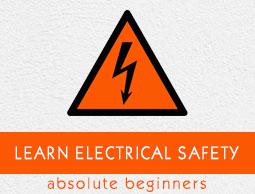Electrical Safety - Earthing
The process of transferring an unintended electrical energy directly to the earth through a low resistance wire is called electrical earthing. It refers to the connection of a noncurrent-carrying part of the equipment or neutral of supply system to the ground, which represents the zero potential. The leakage current chooses the simple low resistance path to flow. Thus, the electrical system and equipment are protected from damage.
Types of Electrical Earthing
The electrical equipment has two non-current carrying parts such as neutral of the system and frame of the equipment. Earthing system is also classified into two types.
Neutral Earthing
The process of connecting neutral of the system to the earth through a GI wire is known as Neutral earthing or System earthing. It is used in star winding systems including generator, transformer, etc.
Equipment Earthing
When the metallic frame of the equipment is connected to the earth by the help of a conducting wire then it is called Equipment earthing. In fault condition in the apparatus, the fault current flows to the earth and the system is protected.
Need of Earthing
Earthing is needed for the following reasons −
To protect the user from electrical shock.
Earthing system shows the easiest path to the fault current even after the insulation failure.
It protects the electrical apparatus used in the circuit from short circuit current, high voltage surges and lightning discharges.
Explanation
We will now understand the need of earthing considering the following conditions −
Normal Condition
Earthing of a system is done in the installation to connect the respective parts with electrical conductors or electrodes. The electrode is placed near the soil or below the ground level, which has flat iron riser under the ground. The noncurrent-carrying parts are connected with the flat iron.
The following figure shows the flow of fault current without earthing system −
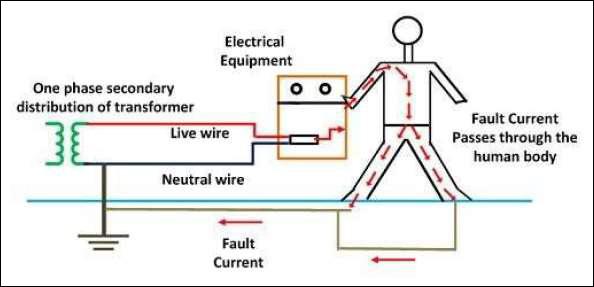
Fault Condition
In a fault condition, the fault current flows from the equipment to the earth through the earthing system. Thus, the apparatus is protected from short circuit or fault current. At the fault time, the voltage of the electrode increases and equals to the resistance of the electrode and the ground fault.
The following figure shows the flow of fault current with an earthing system −
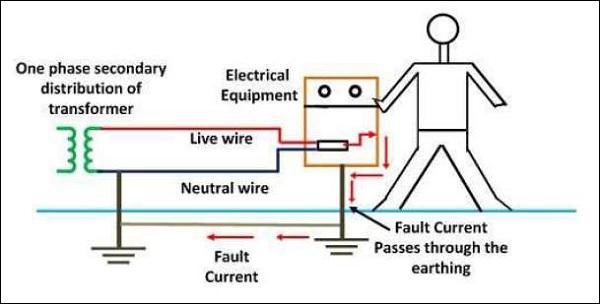
Ground Resistance Measurement
The ground resistance of an electrode is measured by the fall of potential method. The total set up is shows in the figure given below, where -
E is the earth electrode under test
P & C are two auxiliary electrodes placed at a suitable distance from E
I is the amount of current that passes between E and C
V is the measured voltage between E and P
The following figure shows the setup to measure ground resistance −
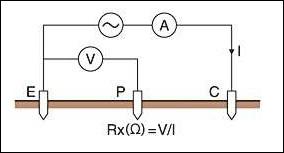
There is no appreciable effect on the resistance of E, if C is at an adequate distance from E. As the current into electrode P is very small, the electrode also has a negligible effect on resistance. Now varying the distance of electrode P from E, the resistance is measured.
The following figure shows the true resistance from the R vs d curve −
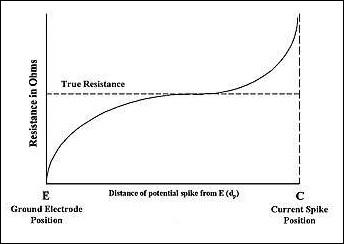
From the figure, the portion of the curve is marked as R of E, which is a nearly horizontal slope in the curve. The upward slope indicates the effect of the resistance of C. For the field measurement earth tester calibration, the ratio is directly used.
Risk reduction
The earthing system must follow the rules and regulations for the risk reduction according to the following standards.
Indian Standards: IS 3043- Code of practice for Earthing (latest)
National Electricity Code (NEC): 1985 of BIS
IEEE guide for safety in AC substation grounding No. ANSI/IEEE standard, 80-1986.
Proper inspection and field survey is necessary before the installation. A flowchart needs to be followed for the different steps: Inspection & Survey – Design – Testing – Installation - Maintenance - Preparing Report.
Electrode resistance, soil resistivity is measured periodically and megger test should be exercised.
Do not use copper or aluminium wire as substitute, paint, enamel and grease on the electrode. Protect the electrode lead from mechanical stress and corrosion.
Proper training and management can reduce the risk factor.


